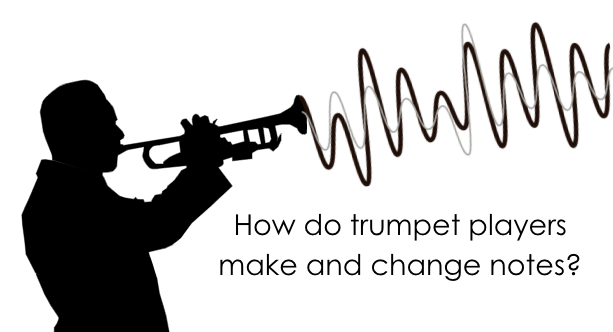
An expert brass player makes changing notes sound and look so simple but when you pick up your instrument as a beginner things can feel very different and quite confusing...so how do trumpet players do it?
What is a brass instrument?
All brass instruments, trumpets included, are just a simple empty pipe. There is nothing in the pipe, mouthpiece or tubing to make any sound.
Where does the sound in a brass instrument come from?
Sound is simply vibrations travelling through the air, like waves travelling through the ocean. In order to create these waves brass players vibrate their lips against each other by blowing air through them. In the brass-playing world, we call this buzzing.
To change the pitch of our buzz we adjust the speed that we blow the air through our lips and the size of the hole or aperture between our lips that the air passes through.
Watch Anthony demonstrate the whole process from buzz to sound on his pBugle:
Once we have a buzz, the instrument will try to vibrate as close to the pitch (how high or low) of the buzz as it can. However, a brass instrument can only play notes from a fixed pattern of pitches on any given length of tubing. This pattern of notes is called the "Harmonic Series" and simply follows the laws of physics.
In the harmonic series, the higher up the pattern we play, the closer together the pitches.
Listen to Anthony play the harmonic series on his pBugle:
Great! Now we have loads of notes and can play bugle calls, like this:
This might seem a bit limiting but before valves were invented it was the only way to play the trumpet (or horn).
If you remember that the notes get closer together as the player plays higher, you can imagine that if you play high enough you can play scales and tunes. This is how trumpet and horn parts were played right up until the 1900s.
These days we call this old-fashioned instrument the "natural" trumpet. It comes in all sorts of lengths, usually quite long, to help fit with the music and make the notes as low and manageable as possible for playing tunes or scales!
So imagine how many different notes we could play on trumpets and horns if we could change the length of our instrument's piping whilst we were playing?
Around the 1890s... ta-da! The valve was invented!
By using valves to add specific, extra lengths of pipe to our instrument we can pick and choose from all the different sets of harmonics to play almost any note we choose.
Listen to Grant play the first, easy notes we can play on all the different combinations of tube length:
So by learning about buzzing and the harmonic series for a length of piping, a trumpet player can deeply understand how their instrument works and master the skill of getting different pitches reliably and easily!
No matter how complicated the music is, every note on the trumpet comes from a buzz!
As an undergraduate Chris studied Jazz at Leeds College of Music and then became a member of the Advanced Studies, post-graduate performers course at the Royal Academy of Music and Principal Bass Trombone with the European Community Youth Orchestra under Claudio Abbado. He then spent 25 years as a busy freelance performer based in both London and the North of England working with a wide variety of ensembles and artists, including being a member of Grimethorpe Colliery Band, The British Philharmonic Orchestra, Dame Shirley Bassey’s Orchestra and the Creative Jazz Orchestra.
Alongside this Chris has worked extensively in all areas of music education, latterly as a leading deliverer and trainer in informal, large group practice. This included roles as Leader in Wider Opportunities at Hertfordshire Music Service, Leader of Instrumental Development for Derbyshire City and County Music Partnership and as a face to face trainer on the Trinity Guildhall/Open University “Whole Class Instrumental Learning” national training program.
He became a key member of the team that created pBone, the plastic trombone in 2011/12 and has been involved with pBone Music in various roles since then. Chris is currently the Director of Creativity and Innovation for the company, a role that includes overseeing product development and improvement, quality and education.
Topics:
